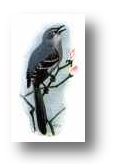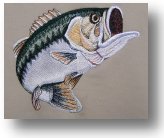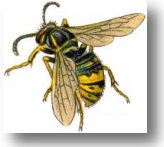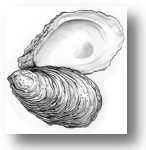
Adopted on January 11, 2021. The flag consists of vertical stripes of red, gold and blue, with a central white magnolia blossom encircled by 20 whites stars, one gold star, and the words “In God We Trust”. It replaces the previous flag that was retired on June 30, 2020
Pledge to the Flag
I salute the flag of Mississippi and the sovereign state for which it stands with pride in her history and achievements and with confidence in her future under the guidance of Almighty God. Reference Miss. Code Ann., Section 37-13-7(1972)

Coat of Arms
The committee to design a Coat of Arms was appointed by legislative action February 7, 1894, and the design proposed by that committee was accepted and became the official Coat of Arms. The committee recommended for the Coat of Arms a “Shield in color blue, with an eagle upon it with extended pinions, holding in the right talon a palm branch and a bundle of arrows in the left talon, with the word “Mississippi” above the eagle; the lettering on the shield and the eagle to be in gold; below the shield two branches of the cotton stalk, saltierwise, as in submitted design, and a scroll below extending upward and one each side three-fourths of the length of the shield; upon the scroll, which is to be red, the motto be printed in gold letters upon white spaces, as in design accompanying, the motto to be –VIRTUTE et ARMIS.”

State Seal
When Mississippi gained statehood in 1817, it decided to use the seal that it had been using since 1798 when Mississippi was still a territory. It bears a modified version of the arms of the United States. The eagle holds an olive branch and arrows, symbolizing the desire for peace but the ability to wage war. The outer circle of the seal holds the words “The Great Seal of the State of Mississippi”.

State Bird
The Women’s Federated Clubs of Mississippi held a state bird campaign, selecting the mockingbird. A bill to designate the mockingbird Mississippi’s official state bird was submitted in 1944.It passed the House 121-0, the Senate 38-0. The mockingbird was signed into law on February 23. Mockingbirds are gray with white patches on their wings. They grow to be about 11 inches long. Mockingbirds copy, or mock, the sounds and songs of other birds.

State Flower/Tree
Mississippi school children were allowed to vote for their state flower on November 28, 1900. The magnolia, cape jasmine, and yellow jasmine were favorites. In all, children voted for forty-two flowers. Out of 23,278 votes, the magnolia received 12,745. It was not made official by the legislature. In 1935, Mississippi’s Director of Forestry started a state tree movement, again allowing school children to vote. The magnolia again won by a landslide. It was adopted on April 1, 1938. On February 26, 1952, the magnolia (Magnolia grandiflora) was finally officially adopted as Mississippi’s state flower. Native to Asia, the magnolia was named for the great French botanist Pierre Magnol, who died in 1715.

State Land Mammal
The White-Tailed Deer (Odocoileus virginianus) was designated the State Land Mammal of Mississippi by Senate Bill No. 2324, General Laws of Mississippi of 1974. The male deer, or buck, grows antlers each year. These antlers are used as weapons during mating season and then are shed. The female deer is called a doe. Doe can give birth to twins or even triplets per season, if well fed.

State Land Mammal 2
The Red Fox (Vulpes vulpes) was designated as an official mammal of Mississippi in 1997. The red fox looks like a small dog with a pointed muzzle, pointed ears, and a long bushy tail. Red foxes are omnivorous, eating a variety of animals and plants. The fox uses a variety of habitats including urban and suburban areas.

State Water Mammal
The Bottlenosed Dolphin (Tursiops truncatus) as the State Water Mammal was approved April 12, 1974. Bottlenose dolphins are small, toothed whales that have a long, beaklike snout, a sickle-shaped dorsal fin, and sharp teeth. Dolphins breathe air through a single blowhole. They grow to be at most 12 feet (3.3 m) long. Dolphins live in small groups of up to 12 whales; these groups are called pods. Bottlenose dolphins have a life span of about 25 years.

State Waterfowl
The Wood Duck (Aix sponsa) was designated the State Waterfowl of Mississippi, Chapter 551, General Laws of Mississippi of 1974. Mississippi boasts more than a million acres of prime game habitat in 36 state wildlife management areas and National Wildlife Refuges open for public hunting, including marshy waterfowl havens. Adult birds are 17-20″ long and tend to inhabit fresh water ponds, lakes, wooded bottomlands, streams, and other wetlands.

State Fish
The Largemouth or Black Bass (Micropterus salmoides) was designated the State Fish of Mississippi, Chapter 551, General Laws of Mississippi of 1974. They have a black to green back with lighter sides and a pale belly. They have a dark wavy band running the length of their sides. Their mouth extends beyond their eyes.

State Insect
The Honeybee (Apis mellifera) was designated the State Insect of Mississippi, Chapter 317, General Laws of Mississippi of 1980. The Mississippi Entomological Association and the Mississippi Beekeepers Association chose the honeybee over the boll weevil and fire ant. Honeybees are social insects. In the wild, they create elaborate nests called hives containing up to 20,000 individuals during the summer months.

State Shell
An act designating the Oyster Shell (Crassostrea virginica) as the State Shell was approved April 12, 1974, Chapter 551, General Laws of Mississippi of 1974. Oysters are soft-bodied animals that have two hard, protective shells (a bivalve). They spend their entire lives in one underwater location. The shape of the oyster’s shells varies, depending mostly upon how crowded they are in the oyster bed.
State Fossil – Prehistoric Whale
A Senate Concurrent Resolution, designating the prehistoric whale as the state fossil, was adopted March 26, 1981. Zygorhiza kochii was an archaeocete, a forerunner of the modern toothed whales (e.g., sperm whales, killer whales, porpoises, etc.) which lived during the Eocene epoch (approximately 37,000,000 to 56,000,000 years ago).
State Stone – Petrified Wood
A Senate Concurrent Resolution, designating petrified wood as the state stone, was adopted May 14, 1976. Petrified Wood is real wood that has turned into rock composed of quartz crystals. The Mississippi Petrified Forest is a privately operated park and museum located at 124 Forest Park Road, Flora, Mississippi.
State Song
Go, Mississippi
Words & Music by Houston Davis
Verse:
States may sing their songs of praise
With waving flags and hip-hoo-rays,
Let cymbals crash and let bells ring
‘Cause here’s one song I’m proud to sing.
Choruses:
Go, Mississippi, keep rolling along,
Go, Mississippi, you cannot go wrong,
Go, Mississippi, we’re singing your song,
M-I-S-S-I-S-S-I-P-P-I
Go, Mississippi, you’re on the right track,
Go, Mississippi, and this is a fact,
Go, Mississippi, you’ll never look back,
M-I-S-S-I-S-S-I-P-P-I
Go, Mississippi, straight down the line,
Go, Mississippi, ev’rything’s fine,
Go, Mississippi, it’s your state and mine,
M-I-S-S-I-S-S-I-P-P-I
Go, Mississippi, continue to roll,
Go, Mississippi, the top is the goal,
Go, Mississippi, you’ll have and you’ll hold,
M-I-S-S-I-S-S-I-P-P-I
Go, Mississippi, get up and go,
Go, Mississippi, let the world know,
That our Mississippi is leading the show,
M-I-S-S-I-S-S-I-P-P-I
